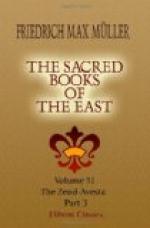“The fair Yima, the good shepherd, O holy Zarathustra! he was the first mortal before thee, Zarathustra, with whom I, Ahura Mazda, did converse, whom I taught the Religion of Ahura, the Religion of Zarathustra. Unto him, O Zarathustra, I, Ahura Mazda, spake, saying: ’Well, fair Yima, son of Vivanghat, be thou the Preacher and the bearer of my Religion!’ And the fair Yima, O Zarathustra, replied unto me, saying: ’I was not born, I was not taught to be the preacher and the bearer of thy Religion.’”
The rest of the Vendidad is taken up with the praises of agriculture, injunctions as to the care and pity due to the dog, the guardian of the home and flock, the hunter and the scavenger. It includes an elaborate code of ceremonial purification, resembling on this point the Leviticus of the Bible, and it prescribes also the gradations of penance for sins of various degrees of heinousness.
E.W.
DISCOVERY OF THE ZEND-AVESTA
The “Zend-Avesta” is the sacred book of the Parsis; that is to say, of the few remaining followers of that religion which reigned over Persia at the time when the second successor of Mohammed overthrew the Sassanian dynasty (A.D. 642), and which has been called Dualism, or Mazdeism, or Magism, or Zoroastrianism, or Fire-worship, according as its main tenet, or its supreme God, or its priests, or its supposed founder, or its apparent object of worship has been most kept in view. In less than a century after their defeat, most of the conquered people were brought over to the faith of their new rulers, either by force, or policy, or the attractive power of a simpler form of creed. But many of those who clung to the faith of their fathers, went and sought abroad for a new home, where they might freely worship their old gods, say their old prayers, and perform their old rites. That home they found at last among the tolerant Hindoos, on the western coast of India and in the peninsula of Guzerat. There they throve and there they live still, while the ranks of their co-religionists in Persia are daily thinning and dwindling away.[9]
As the Parsis are the ruins of a people, so are their sacred books the ruins of a religion. There has been no other great belief in the world that ever left such poor and meagre monuments of its past splendor. Yet great is the value which that small book, the “Avesta,” and the belief of that scanty people, the Parsis, have in the eyes of the historian and theologian, as they present to us the last reflex of the ideas which prevailed in Iran during the five centuries which preceded and the seven which followed the birth of Christ, a period which gave to the world the Gospels, the Talmud, and the Qur’an. Persia, it is known, had much influence on each of the movements which produced, or proceeded from, those three books; she lent much to the first heresiarchs, much to the Rabbis, much to Mohammed. By help of the Parsi religion and the “Avesta,” we are enabled to go back to the very heart of that most momentous period in the history of religious thought, which saw the blending of the Aryan mind with the Semitic, and thus opened the second stage of Aryan thought.




